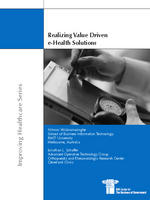
Realizing Value Driven e-Health Solutions

As is well known, health care remains one of the most pressing issues facing us today. The U.S. health care system continues down what most experts have concluded to be an unsustainable path, mired by ever-increasing costs, inconsistent quality, and access pressures. The U.S. spends over $2 trillion on medical care annually which, according to the Organisation for Economic Co-operation and Development (OECD), represents about 2.4 times the average of other OECD countries.
Today, many health care experts are calling for a more collaborative, innovative, and technologically focused health care system. These calls recognize that any real transformation must have specific goals—to improve patient outcomes, to improve access, to reduce cost, and to build a more efficacious paradigm of health and care. e-Health, and the continued adoption and use of health information technology (IT), will play a central role in building a health care system for the 21st century. In an interview during the IBM Center’s “The Business of Government Hour,” Dr. David Blumenthal, National Coordinator for Health Information Technology, said that “health information technology is just a way of collecting and moving a patient’s health information. It’s what I think of as the circulatory system. If you think of information as the lifeblood of medicine, then health information technology is its heart and arteries.”
This report is unique, in that it brings together Professor Wickramasinghe, an IT expert, and Dr. Schaffer, a physician who is managing director of the eCleveland Clinic in Cleveland, Ohio. Together, they present a convincing case that the increased use of information and communication technology holds the promise of both improving health care and reducing health costs. The report is a good introduction to the barriers that need to be overcome in order to significantly increase the use of technology in hospitals and other health care organizations. Barriers include technological, organizational, human, and economic factors.
Professor Wickramasinghe and Dr. Schaffer present an informative description of the elements of e-health and the increasing role of the empowered health consumer. The final section of the report presents a framework in which organizations can assess their potential for moving toward e-health and implementing new technologies. This section describes the infrastructure and processes that need to be put in place prior to deriving any benefit from the “eight e’s” of e-health. Organizations can grade themselves on the e-health preparedness grid. Report recommendations include moving to network-centric health care operations and utilizing appropriate change management techniques to implement e-health solutions. As the authors posit, “The e-health preparedness grid developed in this report serves a dual purpose—it acts as a diagnostic as well as a prescriptive tool to facilitate the transition to a state of high e-health preparedness.”



